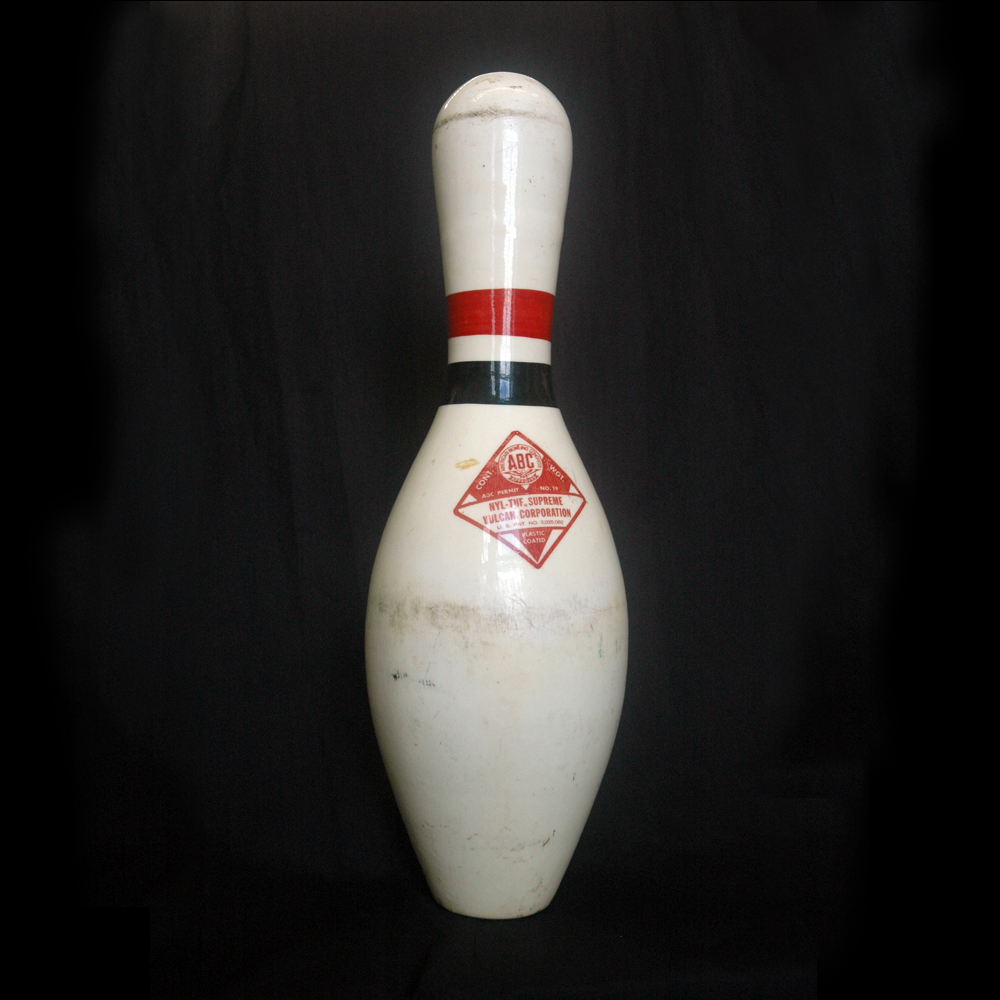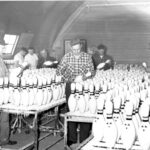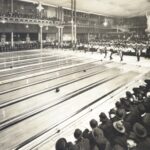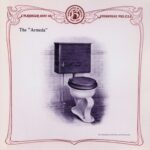This bowling pin was produced by the Vulcan Corporation in Antigo, Wisconsin, sometime in the late 1950s after Vulcan had introduced its patented “Nyl-Tuf Supreme” plastic coating (as indicated by the pin’s red label). The pin complies with American Bowling Congress (ABC) standards, and is currently owned by the Langlade County Historical Society.
The Vulcan Corporation initially manufactured wooden shoe lasts and chose Antigo as its headquarters because of the region’s robust lumber industry and plentiful supply of large maple trees.When demand for shoe lasts waned, Vulcan branched out into various other wood products. Beginning in 1953, the company became a major producer of bowling pins, although shoe last production continued up to 1965 in Antigo, and longer at other plants around the country. About 20% of all bowling lanes in the U.S. used pins manufactured by Vulcan. Bowling pins have always been made exclusively of sugar maple, as specified by the American Bowling Congress, based in Milwaukee from 1905 to 2008. Vulcan used trees from within a 60-mile radius of Antigo. During the 1960s and 1970s, Vulcan also supplied pins for a major bowling boom in Japan.
In 1967, Vulcan employed about 100 men in Antigo. In 1970, Vulcan relocated its head offices to Cincinnati, Ohio, and was the second largest bowling pin manufacturer in the U.S. Boasting 36 plants nation-wide, and producing 21,000 pins weekly, the company at that time also planned to increase production by an additional 4,800 pins per week.
Written by Joe Hermolin, February 2016.

Essay by Joe Hermolin
Hewn from Northwoods maple, this Vulcan Corporation pin reminds us that Milwaukee was once the bowling capital of America. From Wisconsin’s lumbering heyday, to Japan’s abandoned alleys, explore history in the bowling lane.
Listen below to the segment from Wisconsin Public Radio’s Wisconsin Life.
Erika Janik: Bowling may be the sport that made Milwaukee famous, but it was another Wisconsin town that supplied a key ingredient to the sport. Joe Hermolin from the Langlade County Historical Society brings us the story of the Vulcan bowling pin.
Joe Hermolin: Well, the object we have here is a regulation-size bowling pin. It was made in the late-1950s after Vulcan introduced its new, patented Nyl-Tuf Supreme Coating. It was intended to prolong the life of bowling pins from the beating that they took. The choice of wood, pin dimensions, coating, was determined by the American Bowling Congress, which for many years, was based in Milwaukee.
I bowl. I have bowled as a social activity. I never really took it all that seriously. But what really interested me was the story of the Vulcan Company and how it adapted to changing markets, because they came to Antigo to make shoe lasts, and then it evolved into a bowling pin factory. So I was interested, how do you get from one product to another?
The company, first of all, it started out in Ohio, and they made wooden shoe lasts. In 1919, they moved to Crandon, Wisconsin, because of an ample supply of maple wood. And then in 1925 they moved a little bit down the road to Antigo. Antigo also had an ample supply of maple trees. It was also a major railroad hub, and in those days, freight and people all traveled by rail. So Antigo, in a way, was uniquely positioned for a company that wanted to make shoe lasts. They had the raw materials and they had the means of shipping. So that’s where the companies settled in. Starting in the 1940s, the demand decreased, and so they they were looking for other products, and they tried their luck making gun stocks, golf clubs, furniture parts, sewing machine tops, shuffle boards, and wooden high heels for women’s shoes. They did get a contract to make a sort of rough cut bowling pin for Brunswick, which was a major bowling pin manufacturer, and then they decided to get into the bowling pin business themselves.
Period Advertisement: Twenty million men women and children in America are regular bowlers. They make the game our country’s most popular participating sport.
Joe Hermolin: After World War Two, bowling really took off, and automatic pin setters became popular, and the pins really took a beating. So that’s when they came up with a coating. And in 1959, they finally got approval by the American Bowling Congress, and within 10 weeks, they produced their 50,000th pin. Bowling went through same kind of in the first half of the 20th century that many other American kind of activities went through. At first, tournaments were for teams consisting of white males, and eventually, it took a little push, but the American Bowling Congress recognized African American teams, minority teams, women’s teams, into the fold of these bowling tournaments. In the 1950s, as more and more American homes became equipped with television, bowling tournaments on television became very popular. Milwaukee, its program called Bowling with the Champions, was one of their more popular TV shows. So in a way, all these little things about bowling reflect just the evolution of social norms within the country.
Erika Janik: This story was produced with Wisconsin 101. Wisconsin Life is a co-production of Wisconsin Public Radio and Wisconsin Public Television in partnership with the Wisconsin Humanities Council. Additional support comes from Lowell and Mary Peterson of Appleton. Find more Wisconsin life on our website, wisconsinlife.org and on Facebook. I’m Erika Janik.

This object is part of the Langlade County Historical Society Collection in Antigo, Wisconsin. Research for this object essay and its related stories was supported by the museum.





